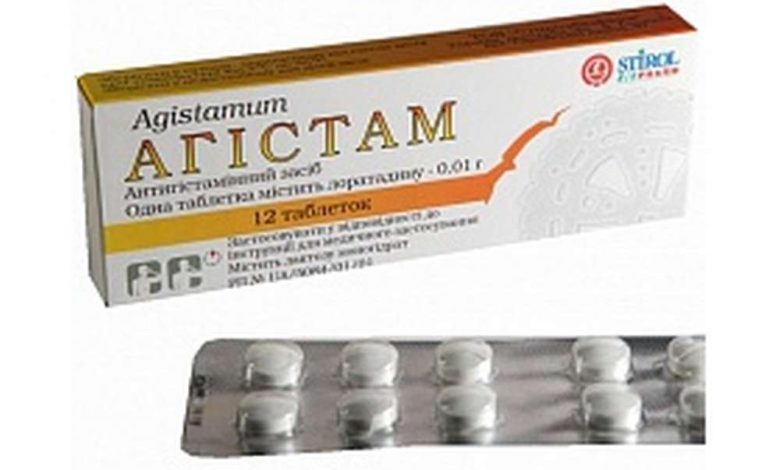Agistam: instructions for using the medicine, structure, Contraindications

Agistam has an antihistamine, antiallergic, antiexudative, antipruritic effect. Selectively blocks H1-histamine receptors and prevents the effect of histamine on smooth muscles and blood vessels. Reduces capillary permeability, exudation, reduces itching and erythema.
The antiallergic effect begins to develop through 30 minutes after oral administration, reaches a maximum after 8-12 hours and persists for at least 24 hours. Agistam does not affect the central nervous system, does not have anticholinergic and sedative effects. No effect on QT interval on ECG. Has a weak bronchodilatory effect.
Agistam: pharmacokinetics
The drug is rapidly absorbed (The maximum concentration in the blood is created through 1,3 o'clock) and extensively metabolized to the active metabolite (descarboethoxyloratadine). The half-life of loratadine is up to 24 hours. About 97% loratadine binds to plasma proteins. During 24 hours 27% the total dose is excreted in the urine as hydroxylated metabolites and/or conjugates. Through 10 days about 80% the accepted dose in the form of metabolites are excreted equally with urine (40%) and faeces (40%).
Agistam: Indications for use
Agistam is used for allergic rhinitis (seasonal and year-round), allergic conjunctivitis, hay fever, chronic idiopathic urticaria, itchy dermatoses (contact allergodermatity, chronic eczema), angioedema. The drug is also used in bronchial asthma (as an aid), with allergic reactions to insect stings, pseudo-allergic reactions to histamine liberators.
Agistam: mode of application
The drug is taken orally. Adults and children over 12 years appoint 10 mg (1 tablet) 1 once a day. Children from 2 to 12 years appoint 5 mg (1/2 tablets) 1 once a day. If the child's body weight is more than 30 kg, appoint 10 mg 1 once a day.
Agistam: side effects
From the nervous system: fatigue, anxiety, excitation (children), dizziness, headache; rarely – asthenia, drowsiness, Nictitating spasm, disfonija, giperkineziya, paresthesia, tremor, amnesia, depression. From the side of the skin and subcutaneous fat: dermatitis. From the urogenital and urinary system: discoloration of urine, tenesmus; dysmenorrhoea, menorragija, vaginitis. Metabolism: weight gain, Sweating, thirst. On the part of the musculoskeletal system: leg cramps, arthralgia, myalgia. From the digestive system: nausea, vomiting, dry mouth, change in taste, constipation or diarrhea, dyspepsia, gastritis, flatulence, Anorexia or increased appetite, stomatitis. The respiratory system: xeromycteria, sinusitis, cough; in some cases – bronchospasm. From the senses: blurred vision, conjunctivitis, pain in the eyes and ears. From the CCC: reduction or increase in blood pressure; perhaps – heartbeat. Allergic reactions: angioedema, hives, itch, photosensitivity. Other: backache, chest pain, fever, chills, breast pain.
Agistam: Contraindications
Increased sensitivity to the drug. The use of the drug in children under the age of 2 years. The active substance of the drug – loratadine, excreted in breast milk, when prescribed, stop breastfeeding.
Agistam: overdose
With a single application 160 ml Loratadine, syrup, side effects and clinically significant ECG changes were not observed. However, with an overdose of loratadine, drowsiness may develop., tachycardia, headache. In such cases, it is necessary to induce vomiting with ipecac syrup., gastric lavage followed by activated charcoal. There is no specific antidote. Further treatment is symptomatic.
With an overdose of agistam tablets (loratadine) the following symptoms are possible: sleep disturbance, tachycardia, hallucinations, convulsions, coma, headache. In case of an overdose of any form of the drug, such treatment is performed: it is necessary to induce vomiting with the use of ipecac syrup, followed by gastric lavage and the use of activated charcoal. Symptomatic and supportive therapy is used.
Agistam: interaction with other drugs
Эritromitsin and ketoconazole, cimetidine increase the concentration of loratadine and its active metabolite in the blood. Loratadine lowers plasma erythromycin levels (on 15%).
Agistam: release form
Agistam: packaging according to 6 or 12 tablets in blisters (10 mg of active ingredient in each tablet). Loratadine: by 10 tablets in blisters (10 mg of active ingredient in each tablet); by 2 blisters in a pack. Syrup in vials 100 ml.
Agistam: storage conditions
List B. Dry, protected from light, at a temperature no higher than 25 ° C. Keep out of the reach of children. Released by prescription.Synonyms:Loratadine, Loratadine, Vero-loratadine, Clargotil, Clarissen, Claritin, Clarifer, Clarotadine, Loradin, Loridine, Tyrlor, Erolin
Agistam: structure
International and chemical name: loratadine – ethyl ether 4-[8-chloro-5,6-dihydro]-1[N-benzo[5,6]cyclohepta[1,2-in] pyridine[1-from the country]-1-piperidine-carboxylic acid.
Agistam: syrup
Basic physical and chemical properties: transparent, viscous liquid with a sweetish-sour taste, yellow color with a characteristic smell of orange or peach. 100 ml of the drug contains Loratadine – 0,10 g. Excipients: propylene glycol – 35,0 g glycerol – 10,0 g food grade sorbitol – 40,0 g of sodium benzoate – 0,20 g citric acid monohydrate – 0,750 g food flavoring “Orange” – 0,1 g or food flavoring “Peach” – 0,1 g dye “Tropeolin” – 0,00040 g purified water – to 100 ml
Agistam: tablets
Tablets of white or almost white color, flat-cylindrical shape with a chamfer. One tablet contains the active substance loratadine - 10 mg, as well as excipients: milk sugar, microcrystalline cellulose, calcium stearate, sodium croscarmellose.
Agistam: additionally
Application features: Loratadine, syrup is not used in newborns. The use of any form of the drug during pregnancy is possible only if, if the expected benefit to the mother outweighs the potential risk to the fetus. Besides, the drug should be stopped for at least 48 h before any skin diagnostic allergy testing to prevent false results. In the period of treatment should refrain from activities potentially hazardous activities, require high concentration and speed of psychomotor reactions.
Attention!You should consult with your doctor before using Agistam.. This manual is provided in a free translation and is intended for informational purposes only.. For more information, please refer to the manufacturer's annotation.
Agistam: general information
- Current in-about: Loratadine
- Farm. Group: Antihistamine medicines
